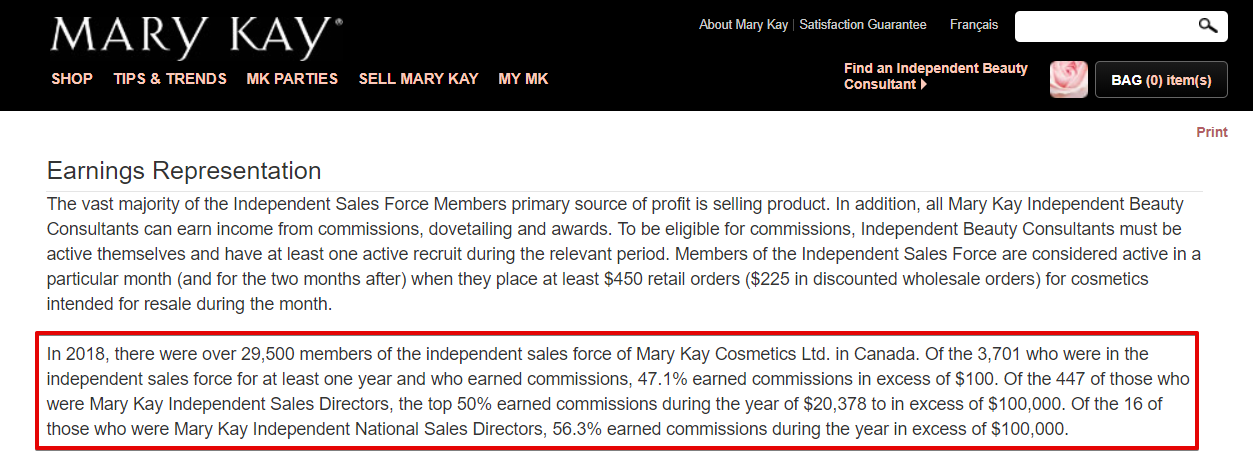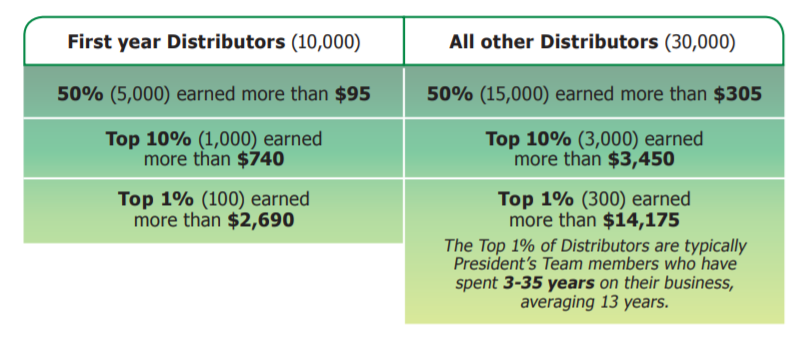MLM's and pyramid schemes are obviously very similar, which is probably the reason you are looking into this right now. But what is the difference? How do you know if an opportunity is an illegal pyramid scheme or a legitimate MLM?
In this article I'll be diving into the difference between a MLM vs pyramid scheme.
The both have a large focus on recruitment of other participants. Maybe your neighbor asked you to join some opportunity or maybe it was some guy sitting at Starbucks. But is that opportunity just another illegal pyramid scheme that you are probably going to lose money from?
*Note: even if it is a legitimate MLM you are looking into you will probably lose money (more on this)
Similarities
Both legal MLM opportunities and illegal pyramid scheme opportunities have the same basic pyramid-like structure.
There are a variety of different forms that the pyramid-like commission structure comes in, but a very basic depiction of one is shown here… (this is called a uni-level compensation plan)

In both business models, as previously mentioned, there is a lot of focus placed on recruitment of other participants. The incentive to recruit more participants into the business is, of course, to make money.
With both opportunities, illegal and legal, you can make money off of the people beneath you. Money flows up the pyramid from the bottom to the top. These opportunities are so attractive because you can recruit more and more people in, thus putting a bigger network beneath you and siphoning more and more commissions up into your pocket. When you recruit people in beneath you, they can then recruit people in beneath them, which you also make money off of.
*This also creates a major problem that I will go over at the end.
The Difference
Pyramid schemes are illegal and legitimate MLM's are legal. But what makes the difference?
What it all comes down to is the sale of legitimate products or services to the general public.
Illegal pyramid schemes: They have no product or service and rely completely on the incoming investments of new participants. Money flows into the pyramid from new investors trying to jump in on the opportunity to make money and then trickles its way up the pyramid into the pockets of the investors that have already joined.
The reason pyramid schemes are illegal is because they are a serious hazard to the people buying into them. They are doomed from the very start. Once the steady flow of new investors starts to slow down, the entire operation begins to implode, and unfortunately the majority of participants end up losing money. This is the way it is and the way it will always be because there are not actually any products or services being sold. There is no real value.
Legitimate MLMs: They sell real products and/or services. They still have the same basic pyramid-like structure where commissions trickle up the pyramid into the pockets of those at the top, but at one time or another the money is made by the sale of real products and/or services, not just investments.
Another key element of a legitimate MLM is that the real products and/or services are being sold to the people who actually want them. There are many pyramid schemes disguised as MLM's that exist where participants are forced to purchase products/services in order to join the opportunity. Sure, in this case the revenue would be coming from the sale of legitimate products/services, but they are not being sold to willing buyers.
Note: MLM refers to the same basic thing as network marketing. You hear these terms used interchangeably often.
The Purpose of a Legitimate MLM
The purpose of a MLM is marketing strategy. It is all about growing the business and a MLM business model is a quick and cost-effective way to do this. It creates incentive for participants (distributors) to recruit in new distributors and help grow the business.
The purpose of a pyramid scheme is purely to make quick money before it eventually implodes, which any smart participant knows is going to happen at some point.
How to Distinguish Between the Two
Some good tips provided by the FTC for avoiding illegal pyramid schemes include the following…
1) Is there a product or service being sold?
Obviously this is the first question you want to ask yourself. As I have just went over, pyramid schemes do not sell products or services. Well, I should say at least in their pure form they do not. But, the lines are a bit more blurry and not so cut and dry, as I will go over shortly.
2) Who is buying this product or service?
Next you should look at who is buying the product or service. Is it being sold to willing buyers or is it being forced down participants' throats?
3) Is there a focus on selling to the general public?
This goes along with the previous question… Is there incentive to sell to the general public? If there isn't much incentive to do so in the compensation plan then people simply will not do much of it, and this is not a good sign.
4) Do they buy back unsold inventory?
Some companies have policies where they will actually buy back unsold inventory. So if you buy a bunch of products trying to advance as quickly as possible but end up failing, the company will buy them back from you. This really helps protect the participants and is a nice safeguard to have in place.
If you do see a company that has a policy like this, it is probably legitimate. However, you won't see this all too often and many times if you do see it the company makes it ridiculously difficult to go through the process of actually having them buy back your unsold inventory.
But It's Not So Cut and Dry
As mentioned, it is not so cut and dry. The answer is not so straightforward. If it were, there would probably be no reason for me to write this article right now.
There are a lot of pyramid schemes out there that are cloaked as being MLM's and there are a lot of MLM's out there that drift a little bit too far towards the pyramid scheme side of things.
Participants are often forced to purchase products... which isn't necessarily a bad thing
New recruits often have to purchase a certain amount of products, such as a "starter kit", in order to qualify to start receiving commissions.
And while this can be a bad sign, it isn't necessarily. In fact, I think that distributors need to know what they are dealing with and what they are promoting. How is a distributor supposed to promote a business if they don't even know the products that the business sells? By requiring new distributors to purchase products like this eliminates that problem.
However, when does this become too much?
The problem arises when a significant portion of the company's revenues comes from new distributors being forced to purchase products. And some companies even require distributors to purchase products on a monthly basis in order to stay "qualified".
What it all comes down to is how much money they are making from the sales of willing buyers. If there is not enough money coming in from people actually want to purchase the products, there is a serious problem and a good chance that the particular opportunity could be labeled a pyramid scheme, which would be shut down.
Nowadays companies seem to be getting away from the whole "forcing distributors to buy" thing.
Legit MLMs - Ya... You Might Want to Avoid Them Too!
Unfortunately even if you do come across a legitimate MLM you might want to rethink your decision to join.
You've probably heard stories about how MLM's have incredibly high turnover rates, most people lose money and so on. These stories are all true.
According to a study by Jon M Taylor of the Consumer Awareness Institute, 99% of people who get involved in MLM opportunities end up losing money.
How crazy is that… 99%!
In this study he analyzed over 350 different MLM's and found that they were all largely recruitment-driven and "top-heavy", meaning that the small percentage of people at the top of the pyramid-like structure were reaping most of the rewards.
I'll be going over the core problem with MLM's, which pretty much guarantees most people's failure, but first let's take a look at some statistics…
Numbers Don't Lie - And Wow Are They Ugly!
Numbers don't lie, and if you have never seen statistics for MLM opportunities you might be surprised at what you see here.
Unfortunately many MLM's do not show their statistics for distributor earnings, and many that do make them difficult to understand and confusing, but I found some pretty shocking stats to show you that will give you an idea of the reality at hand.
MLM earnings statistics I'll be going over include that for Tupperware, Nu Skin, Mary Kay and Herbalife, which are some very well known MLM opportunities. Most of these earnings statistics are a bit old because it takes a while for companies to disclose their findings, but they don't change much over the years anyhow and still show the harsh reality here.
Tupperware:
Unlike many of the other income disclosure as I have come across, the Tupperware income disclosure is actually easy to understand and shows you exactly what is going on. They do not try to mislead people and act as if the opportunity is better than it is.
Below you can see the chart. Right off the bat, you can see that 94.01% of all active participants are at the "consultant" rank and earned an average of $484.70 for the period at hand, which for some reason was a 10 month period from August to May.
Only about 1% of the entire base of active participants earned $9000 or more for the 10 month period... Pretty darn low.

Nu Skin:
The compensation summary for Nu Skin isn't any prettier, but it is definitely a lot more confusing. Nu Skin, as a lot of companies do, presented their stats in a way that doesn't paint a very clear picture of what is actually going on, probably in an attempt to make it look better than it really is.

Only about 2% of all participants earned more than $10,000 in commissions for the entire year. And what they do not make very clear is that only 15.41% of active Distributors actually made any money, meaning that 84.59% of active Distributors earned nothing at all.
Mary Kay:
There were over 29,500 members of the sales force at Mary Kay in 2018. Only 3701 members had been there for at least a year, which reflects the incredibly high turnover rates that MLM companies experience.
And, of these 3701 members only 47.1% earned commissions of over $100, meaning that 52.9% earned less than $100.
447 people made it to the Director rank and the top 50% of those earned $20,378 to $100,000 or more. 16 people made it to the rank of National Sales Directors, and 56.3% of these people (weird statistic, I know) made more than $100,000.

Herbalife:
Lastly, let's take a look at Herbalife's compensation summary.
In 2017 they had around 40,000 distributors, 10,000 of which were first-year distributors.
Of the 10,000 first-year distributors, only about 50% earned more than $95 for the entire year. The top 10% (1000 distributors) earned more than $740, and the top 1% (100 distributors) earned more than $2690.
For all other distributors, only about 50% earned more than $305 and only the top 1% earned more than $14,175...

The disclosure by Herbalife doesn't tell us much. They only show statistics for people earning up to $14,175.
Was there anyone to earn more than this? That really isn't all that much money for an entire year. Is there anyone is actually making good money? Who knows… But one things for sure, if there is, the number is very few.
Pro Tip: Always, always, always look for earnings disclosures before getting involved with any opportunity like this. If they don't provide one that you must ask the question: why not? What are they hiding?
I could go on and get about 30 more examples of income disclosures that look like those above, but I do not want to bore you. They all show the same thing… Which is a very small percentage of people actually making good money. And the reason for this is a fundamental flaw of the MLM structure…
The Flaw of MLM - Why You Are Almost Guaranteed to Fail
The study I mentioned earlier, where the guy analyzed over 350 MLM's, found that all of them were recruitment driven and top weighted, and this is due to the very basic structure they have.
I'm talking about the pyramid-like structure where money flows from the bottom to the top…

This type of commission structure creates enormous potential to earn incredibly high amounts of money… IF YOU MAKE IT TO THE TOP!
The problem is that the odds will always be greatly stacked against you. Of course, there are always going to be many more people at the bottom than at the top. That is just the way it works and the way it will always be.
The people at the bottom have it hard; they have money that they could possibly be making being sucked away from them and paid to those above them. The people at the top have it good; they receive a bunch of commissions from those below them.
MLM opportunities would work out okay if there was endless numbers of people to recruit in, but the reality is that there are not. The market is not infinite, which is why you often see MLM opportunities that are focused too much on recruitment drying up after they have saturated the market.
MLM vs Pyramid Scheme - Who Wins?
Although there are legitimate MLM opportunities that differ from pyramid schemes, should you really be getting involved with either?
And does it really matter whether it is a pyramid scheme or not? Although the illegal pyramid scheme does stand a chance of getting shut down, financially speaking they seem to be pretty similar choices. In fact, in some situations you could probably stand a better chance of making money from an illegal pyramid scheme, but of course this is not something I would recommend joining.
But anyways… I hope this article has been of help to you. I hope I was able to clearly show you the difference between these 2 types of opportunities and give you a realistic view of their potential.
MLM opportunities are often promoted as the greatest thing to ever bless this earth, but this is often because a member is just trying to recruit you into their downline so that they can make more money. They are often mis-represented and because of this a lot of people end up getting involved that do not really know what they're getting involved with.
Please share this article to help spread the truth.

